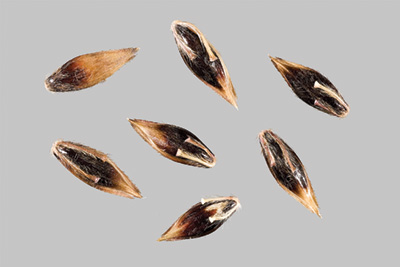Stem
- Up to 8 ft. tall; many tillers arise from crown; stems slightly flattened with prominent nodes
Leaves
- Up to 2 ft. long, 0.25-0.75 in. wide, white midvein and mostly hairless except near collar; ligule is membranous and tipped with fine hairs; NO auricles
Flower
- Seedhead open and pyramid-shaped; purplish-brown at maturity
- Seed is narrow, less than 0.25 in. long and reddish-brown to black

Photo of Johnsongrass seeds
Root
- Deep, fibrous root system; rhizomes are white and fleshy with brown to purple nodes; roots and new plants often form at nodes
Other
- Grows best in moist soils; often found in crop fields, pastures, fencerows, roadsides, and along waterways; known to occur in Clark, Lincoln, and Lyon counties
- Perennial; reproduces by seed and rhizomes; seedlings resemble corn and can best be identified by pulling a plant and examining the roots for an attached seed
- Plants can be toxic to livestock after frost or drought
Control
- Frequent mowing or tillage is effective; burning is NOT
- Apply fenoxaprop, fluazifop, or sethoxydim to actively growing plants before boot stage; glyphosate, imazapic, or imazapyr between boot and bloom stages
Blecker, L., Creech, E., Dick, J., Gephart, S., Hefner, M., Kratsch, H., Moe, A., Schultz, B.
2020,
Nevada Noxious Weed Field Guide – Johnsongrass,
Extension, University of Nevada, Reno, Field Guide


